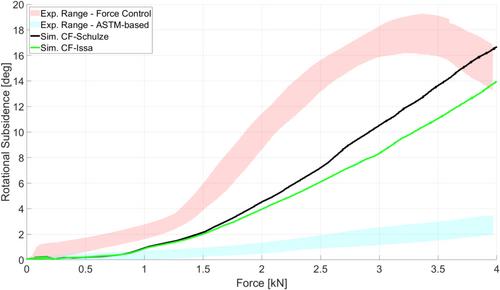Evaluation of a Force-Control Experimental Method to Perform Unconstrained Load-Induced Subsidence Testing of Spinal Interbody Implants
Abstract
Introduction
Intervertebral body fusion devices (“interbody cages”) used in spinal surgeries are susceptible to axial and/or rotational subsidence into the underlying vertebral bone. Experimental testing standards to examine implant subsidence, such as ASTM F2267, simplify the implant loading conditions and vertebral bone materials for ease of use and repeatability. Yet, the ability to assess clinically relevant risk of rotational subsidence with these methods is limited.
Methods
The present work aimed to develop and evaluate a novel force-control (FC) test method for performing unconstrained load-induced implant subsidence into a heterogeneous material interface. The developed method was compared to the ASTM F2267 method, which uses a lubricated ball-and-socket joint, using the AMTI VIVO joint motion simulator to apply unconstrained loading up to 4 kN. Subsidence testing was performed on two different polyurethane (PU) foam densities (rigid 20 and 30 PCF) sandwiched together providing a heterogeneous boundary interface to induce implant rotation into the less dense foam.
Results
Axial and rotational subsidence values varied significantly between the two test methods (p < 0.05). Unconstrained axial compression up to 4 kN yielded, on average, 2.5 ± 0.4 mm of axial subsidence for ASTM-based setup compared to 4.8 ± 0.6 mm for the FC setup. The ASTM-based setup had an average implant rotation of 2.8° ± 0.5°, in contrast to the FC setup, with an average of 18.0° ± 0.9°. Additionally, the experimental FC results had good agreement with a computational finite element model of the same FC setup and PU foam materials.
Conclusions
This new FC method for unconstrained load-induced subsidence testing demonstrates potential improvements in consideration for rotational implant subsidence and the associated clinical burden in spinal surgery.


 求助内容:
求助内容: 应助结果提醒方式:
应助结果提醒方式:


